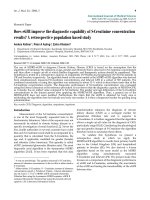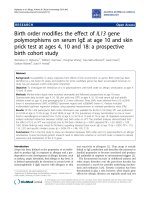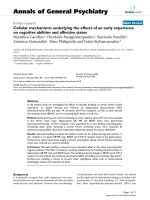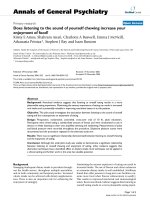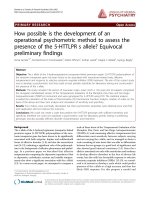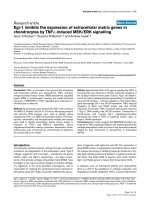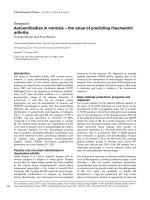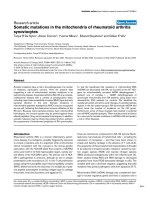Báo cáo y học: "Does listening to the sound of yourself chewing increase your enjoyment of food" ppt
Bạn đang xem bản rút gọn của tài liệu. Xem và tải ngay bản đầy đủ của tài liệu tại đây (209.06 KB, 5 trang )
BioMed Central
Page 1 of 5
(page number not for citation purposes)
Annals of General Psychiatry
Open Access
Primary research
Does listening to the sound of yourself chewing increase your
enjoyment of food?
Kirsty E Amos, Shahram Anari, Charlotte A Buswell, Emma J McNeill,
Athanasia Printza*, Stephen J Ray and Isam Rustom
Address: Under the Auspices of the Master of Science in the Speech and Swallowing Research Course, University of Newcastle upon Tyne, UK
Email: Kirsty E Amos - ; Shahram Anari - ;
Charlotte A Buswell - ; Emma J McNeill - ;
Athanasia Printza* - ; Stephen J Ray - ; Isam Rustom -
* Corresponding author
Abstract
Background: Anecdotal evidence suggests that listening to oneself eating results in a more
pleasurable eating experience. Maximising the sensory experience of eating can result in increased
oral intake and is potentially valuable in improving nutritional status in at-risk patients.
Objective: This pilot study investigates the association between listening to the sound of oneself
eating and the consequences on enjoyment of eating.
Design: Prospective, randomized, controlled, cross-over trial of 10 fit, adult volunteers.
Participants were timed eating a standardised amount of bread, and were randomized to eat in
silence or whilst listening to their own amplified chewing and swallowing. Measurements of pulse
and blood pressure were recorded throughout the procedure. Subjective pleasure scores were
documented and the procedure repeated in the alternate study arm.
Results: There was no significant relationship demonstrated between listening to oneself chewing
and the enjoyment of eating.
Conclusion: Although this small pilot study was unable to demonstrate a significant relationship
between listening to oneself chewing and enjoyment of eating, other evidence suggests that
distraction techniques have a beneficial effect on dietary intake. Such techniques can be applied in
a clinical setting and further work in this area has valuable potential.
Background
Managing inadequate dietary intake is prevalent through-
out the health service, throughout multiple specialities,
and in both community and hospital practice. Increased
calorie intake can be achieved with dietary supplementa-
tion. There is also an important role for enhancing the
enjoyment of eating[1].
Maximising the sensory experience of eating can result in
increased intake. The use of flavour and odour enhancers
to maximise dietary intake is well established. Schiffman
found that older persons in long-term care facilities con-
sume more food when flavour enhancement is used[1].
This results in improved functional and immunological
status. Recent anecdotal evidence suggests that listening to
oneself eating results in a more pleasurable eating experi-
Published: 29 November 2006
Annals of General Psychiatry 2006, 5:22 doi:10.1186/1744-859X-5-22
Received: 17 November 2006
Accepted: 29 November 2006
This article is available from: />© 2006 Amos et al; licensee BioMed Central Ltd.
This is an Open Access article distributed under the terms of the Creative Commons Attribution License ( />),
which permits unrestricted use, distribution, and reproduction in any medium, provided the original work is properly cited.
Annals of General Psychiatry 2006, 5:22 />Page 2 of 5
(page number not for citation purposes)
ence[2]. Bellisle et al demonstrated that listening to back-
ground noise while eating results in increased intake[3].
The ability to positively encourage oral intake without
recourse to medication would be extremely valuable for
many client groups.
Research by Cuevas et al demonstrates an increase in swal-
lowing rate in conditions of emotional arousal [4]. Bel-
lisle also showed that chewing time is reduced if food is
more palatable, and the experience of eating more pleas-
urable [5]. It would, therefore, seem logical that chewing
and swallowing time could be used as a reflection of the
palatability of food, and the pleasure of eating.
Differing and distinct cardiovascular responses can be
seen following exposure to emotional stimuli [6]. In par-
ticular, pleasurable experiences are reflected by an
increase in pulse and blood pressure without an overall
increase in cardiac output[6]. Therefore, a pleasurable eat-
ing experience would be reflected by such changes in
pulse and blood pressure measurements. If eating is more
pleasurable as a result of listening to oneself chewing,
chewing time would decrease and there would be a
demonstrable cardiovascular response.
This study investigated whether listening to oneself chew-
ing increases the pleasure of eating.
Methods
Subjects
Ten healthy volunteers were recruited from the students at
the University of Newcastle-upon-Tyne (UK). Inclusion
criteria included: consent to participate, and literacy suffi-
cient to read instructions. Exclusion criteria were: hearing
impairment, history of eating and drinking difficulties,
food allergy, systemic medical problem (e.g. diabetes mel-
litus) or psychiatric disease.
Design
Prospective, randomized, controlled, cross-over trial of 10
fit, adult volunteers. Pilot study.
Procedure
Written informed consent was obtained. Height and
weight were recorded in order to reflect the body mass
index (BMI) of the participants. The BMI was estimated to
exclude participants with eating disorders not acknowl-
edged by them, since eating disorders influence the per-
ception of eating pleasure.
Participants were block randomised to determine whether
they would experience condition 'A' or condition 'B' first.
Condition 'A' specified absence of amplified chewing
sounds when the participants were chewing in a quiet
room.Condition 'B' specified the condition when partici-
pants were listening to their chewing sound amplified and
heard through the loud speakers placed half a metre in
front of them.
To ensure consistent hunger for both conditions, partici-
pants did not eat or drink for two hours before each con-
dition. This was monitored by participants indicating
their hunger level on a Visual Analogue Scale (VAS) scaled
from one to ten (with one indicating the least hunger)
before starting to eat. Participants sat at a table and read
an instruction sheet. The continuous cardiovascular mon-
itor probe was placed on their non-dominant hand allow-
ing them to feed themselves with their dominant hand.
The diaphragm of the stethoscope was placed under the
angle of the mandible by one researcher, and held
throughout the procedure. The flat diaphragm was used
for optimal amplification of the frequencies of both the
chewing and the swallowing sounds. The loudspeaker was
either on or off according to condition B or A respectively.
Participants ate one slice of bread at their own pace, and
raised their hand to indicate when they perceived that
they had swallowed all the bread and butter. One slice of
white bread and butter (cut into four pieces) was used per
participant in each condition. Systolic and diastolic blood
pressure and also pulse were continuously measured dur-
ing eating. Time taken to eat the bread was measured from
when the leading edge of the first piece of bread passed
the lips, to when the participant raised their hand. On
completion of the first condition, participants were asked
to rate their enjoyment of the eating experience on the vis-
ual analogue scale. Two hours later each participant then
repeated the procedure under the other condition (A or B
as above).
Equipment
Equipment consisted of the following:
1) A personal computer [Toshiba notebook computer
with Pentium processor (Intel, Santa Clara, CA, USA), a
National Instruments (Austin, TX), DAQ pad 6020E (12
bit analogue to digital card), and Lab Microsoft Windows
XP software]. 2) Pulse and blood pressure monitor [Fin-
apres Datex Ohmeda 2300 (continuous cardiovascular
monitor)]. 3) An amplifier [Chewing and swallowing
sounds were amplified by a Littmann Cardio II stetho-
scope – St Paul, MN, USA – modified with two channel
microphone amplifier FM317 and Yamaha MS101 moni-
tor]. 4) A chronometer to measure the chewing time. 5)
Scales and measuring tapes [Weight was measured using a
domestic set of Salter scales and height by a tape fixed to
a wall]. 6) Video camera [The experiment was recorded
using a Panasonic M50 video camera.]
Annals of General Psychiatry 2006, 5:22 />Page 3 of 5
(page number not for citation purposes)
Statistical analysis
The baseline physiologic parameters and the hunger VAS
were compared between the two conditions using a paired
t-test to ensure that no difference was present. In order to
assess the change in the physiological parameters, the
paired-sample t-test was used to compare the variables
between the groups and within the same group. The pre-
eating measurement was compared to the mean of the
recording of each parameter for each participant during
eating. The mean score was used as there was a continuous
recording of the pulse and blood pressure through the
Finapres machine. The variables assessed for comparison
were:the mean/systolic/diastolic blood pressure, pulse
rate, pre-eating hunger VAS and the post-eating pleasure
VAS.
Results
Ten participants were recruited for the study. The demo-
graphics of the study population are presented in Table 1.
There was no significant difference between the baseline
variables between the two conditions (Table 2). There was
no significant change in the physiological parameters in
either condition (Table 3). There was no statistically sig-
nificant difference between conditions 'A' and 'B' in the
time taken to eat or the VAS scoring of the pleasure of eat-
ing (p value 0.88 and 0.63 respectively). The power of this
study was approximately 27% at the best (a retrospective
power calculation using the systolic blood pressure data).
A sample size of minimum 40 participants is needed to
achieve a power of 80% with confidence level of 95%.
Discussion
In affluent societies eating is a pleasure and people do not
eat merely to live. In addition to the physiological proc-
esses, eating behaviours are influenced by many factors -
behavioural, social and environmental [7]. As a result,
there are different methodologies applied to study differ-
ent aspects of eating behaviours. A report on an actual
'experiment' of enhancing the enjoyment of eating by lis-
tening to the chewing sounds stimulated our interest [2].
We planned a study to evaluate a possible effect of listen-
ing to chewing sounds on the pleasure of eating.
The pleasure of eating is influenced by many parameters.
In addition to satiation of one's hunger and the taste of
the meal, certain social and environmental factors influ-
ence the pleasure. Although the complexity of the human
brain makes it very difficult to apply general rules to the
prediction of even straightforward behaviours such as eat-
ing, we tried to evaluate the level of pleasure by measuring
changes in physiological parameters.
It has been shown that increased emotional arousal in
healthy individuals is related to increased swallowing rate,
as measured by the number of swallows per minute [4].
Bellisle et al showed that increased palatability of food
increases the swallowing rate and reduces the chewing
time [5]. Based on these reports we selected the duration
of chewing as the outcome measure. Hetherington reports
on studies showing that pleasure derived from eating a
specific food is high at the beginning of a meal and stim-
ulates further eating, but as eating progresses the partici-
pants report a decline in the pleasantness of the specific
food [7]. By selecting a small test meal we attempted to
prevent this effect from affecting our results.
There are discrete emotion-specific autonomic nervous
system activities during periods of joy, sadness, fear, and
anger. Sinha et al showed that the cardiovascular
responses to joy were an increase of the heart rate and the
systolic blood pressure without a significant increase of
the diastolic blood pressure or the cardiac output [6]. In
our study we continuously recorded the heart rate and the
systolic, diastolic and mean blood pressure during the test
period. Changes in these cardiovascular indices were the
measure of increased enjoyment during eating.
Readiness to eat has been evaluated in different studies by
recording blood glucose dynamics, by examining saliva-
tion and by self-reported hunger [7]. Self-report of hunger
prior to test meals is a widely used tool in the research of
eating behaviours. We used a Visual Analogue Scale of
hunger. Meal eating patterns have been shown not to be
sensitive to the level of food deprivation [5]. They were as
responsive to sensory factors after an overnight fast, as
after a usual breakfast to lunch interval. Therefore, our
participants were expected to have almost equal levels of
pre-test hunger in both phases of the study.
A pleasure VAS was considered important to elicit a direct
response to the meal by participants. It is difficult to dis-
tinguish between measures of hunger, appetite and enjoy-
ment of eating [7].
The choice of test meal is very important in the research in
eating behaviour in humans. Quantities, types and tex-
tures vary and their selection depends on the research
question [5,7]. In our study, a slice of bread was selected
as it is generally considered palatable, is a small meal,
requires chewing and is easy to chew regardless of partici-
pant's dental status. Studies have shown that meals inter-
rupted for comments on palatability last longer and
involve greater quantities of food [7]. In this study, partic-
Table 1: Demographics of the study population (n: 10)
Female/Male 7/3
Age range (mean) 28–42 (33.4)
BMI* range (mean) 19–31 (26)
*BMI: Body Mass Index
Annals of General Psychiatry 2006, 5:22 />Page 4 of 5
(page number not for citation purposes)
ipants were instructed to eat the whole slice of bread with-
out interruption for comments or drinking. Test meals
consisting of different food consistencies, producing more
chewing sounds should be considered in future studies.
Other methodological considerations to take into account
are that the artificial conditions of a laboratory setting
may affect eating behaviours. During test meals, three
researchers were present in the room with the participant.
Being observed while eating may affect eating behaviour.
These are important limitations of any eating behaviour
study. It must be noted that the participants had visual,
tactile and olfactory access to the food item in addition to
the auditory effect. It would be interesting to exclude
other sensory inputs while evaluating the potential
enhancement of eating pleasure by listening to chewing
sounds.
In this study, there was no significant difference in the
pleasure scores and in the time taken to chew and swallow
one slice of bread between two different test conditions.
There were also no significant changes of cardiovascular
indices between the two meal conditions. Although an
order effect was not anticipated in this study participants
were randomly assigned to either have the meal with or
without listening to the chewing sounds first.
The magnitude of the intervention effect may have been
insufficient to produce a measurable result. There is no
evidence regarding the sound pressure level generated by
a loudspeaker that would be considered as pleasant and
sufficient to produce an effect. The room was quiet but not
sound-treated, as a result there was some background
noise and noise from the recording equipment. Cervical
auscultation for dysphagia is usually performed at the lat-
eral aspect of the neck [8,9]. In this study a modified steth-
oscope was located immediately below the angle of the
jaw.
The magnitude of stimulation (eating and/or enjoyment)
necessary to produce cardiovascular reactions detectable
through blood pressure and pulse changes is not known.
Changes in blood pressure and pulse rate in other studies
were elicited with a methodology that involved stronger
stimulation over longer periods [6]. The effect of control-
led experimental conditions in laboratory settings on the
pleasure of eating may be greater than the effect of the
experimental intervention. This is a limitation of these
types of studies.
To our knowledge, this is the first study to assess the effect
of listening to chewing sounds on the pleasure received
from eating. This pilot study did not show a relationship
between listening to oneself chewing and enjoyment of
eating. One reason may be the fact that the study popula-
tion was small and so failed to generate sufficient power
for analysis. A further study with a greater number of par-
ticipants may identify some trends of influence.
Table 2: Comparison of the variables at baseline between the conditions.
Condition 'A' Condition 'B'
Variables Pre-test mean (SD) Pre-test mean (SD) p value
Systolic BP (mmHg) 137.8 (19.7) 140.0 (17.6) 0.82
Diastolic BP (mmHg) 105.1 (10.5) 107.1 (15.7) 0.76
Mean BP (mmHg) 118.1 (13.8) 120.5 (15.3) 0.76
Heart Rate (Beats/min) 75.6 (12.7) 70.2 (10.6) 0.38
VAS*- Hunger 60.7 (20.8) 54.1 (29.9) 0.42
*VAS: Visual Analogue Scale
Table 3: Measurement of variables before and during the test for each condition.
Condition 'A' Condition 'B'
Variables Pre-test Mean (SD) During test Mean (SD) p value Pre-test Mean (SD) During test Mean (SD) p value
Systolic BP (mmHg) 137.8 (19.7) 136.0 (23.0) 0.85 140.0 (17.6) 128.1 (15.1) 0.17
Diastolic BP (mmHg) 105.1 (10.5) 111.7 (18.0) 0.39 107.1 (15.7) 106.4 (13.1) 0.91
Mean BP (mmHg) 118.1 (13.8) 123.8 (20.5) 0.52 120.5 (15.3) 117.8 (13.4) 0.68
Heart Rate (Beats/min) 75.6 (12.7) 78.0 (9.5) 0.50 70.2 (10.6) 76.9 (8.7) 0.14
Condition 'A': with no amplification of chewing sound; Condition 'B': with amplification of chewing sound.
Publish with BioMed Central and every
scientist can read your work free of charge
"BioMed Central will be the most significant development for
disseminating the results of biomedical research in our lifetime."
Sir Paul Nurse, Cancer Research UK
Your research papers will be:
available free of charge to the entire biomedical community
peer reviewed and published immediately upon acceptance
cited in PubMed and archived on PubMed Central
yours — you keep the copyright
Submit your manuscript here:
/>BioMedcentral
Annals of General Psychiatry 2006, 5:22 />Page 5 of 5
(page number not for citation purposes)
Acknowledgements
We would like to thank Michael Drinnan for his assistance in the data anal-
ysis, and Paula Leslie for her advice throughout the study.
References
1. Schiffman SS, Warwick ZS: Effect of flavour enhancement of
foods for the elderly on nutritional status: Food intake, bio-
chemical indices, and anthropometric measures. Physiol Behav
1993, 53:395-402.
2. Coren G: Chez Kristof. [ />0,,1147_1293730,00.html ].
3. Bellisle F, Dalix AM: Cognitive restraint can be offset by distrac-
tion, leading to increased meal intake in women. American
Journal of Clinical Nutrition 2001, 74(2):197-200.
4. Cuevas JL, Cook EW 3rd, Richter JE, McCutcheon M, Taub E: Spon-
taneous swallowing rate and emotional state. Possible mech-
anism for stress-related gastrointestinal disorders. Digestive
Diseases & Sciences 1995, 40(2):282-286.
5. Bellisle F, Guy-Grand B, Le Magnen J: Chewing and swallowing as
indices of the stimulation to eat during meals in humans:
effects revealed by the edogram method and video record-
ings. Neuroscience & Biobehavioral Reviews 2000, 24(2):223-228.
6. Sinha R, Lovallo WR, Parsons OA: Cardiovascular differentiation
of emotions. Psychosomatic Medicine 1992, 54(4):422-435.
7. Hetherington MM: The physiological-psychological dichotomy
in the study of food intake. Proceedings of the Nutrition Society
2002, 61(4):497-507.
8. Cichero JA, Murdoch BE: Detection of swallowing sounds:
methodology revisited. Dysphagia 2002, 17(1):40-49.
9. Cichero JA, Murdoch BE: Acoustic signature of the normal swal-
low: characterization by age, gender, and bolus volume.
Annals of Otology, Rhinology & Laryngology 2002, 111(7 Pt 1):623-632.


